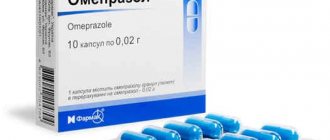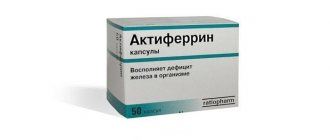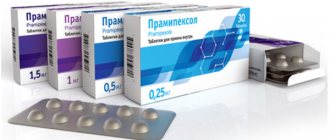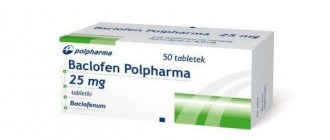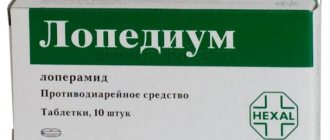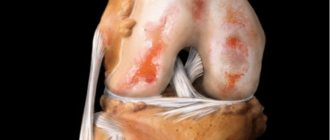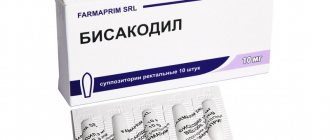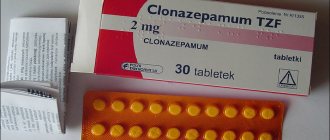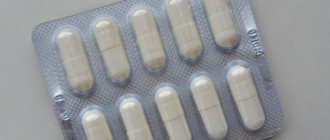Release form and composition
Streptokinase is produced in the form of a lyophilisate for the preparation of a solution for intravenous and intra-arterial administration: white with a yellowish tint, porous, hygroscopic mass, compacted into a tablet (750,000 or 1,500,000 international units (IU) in bottles; 1 bottle in a cardboard box).
1 bottle of lyophilisate contains:
- active ingredient: streptokinase – 750,000 or 1,500,000 ME;
- auxiliary components: sodium L-glutamate, polygelin.
Interaction
Acetylsalicylic acid , dextrans, Dipyridamole, coumarin derivatives, heparin, valproic acid can increase the risk of bleeding and also enhance the effectiveness of the drug Streptokinase.
When using antifibrinolytic drugs, the opposite effect is observed.
The medication is completely incompatible with plasma replacement drugs: dextran , hydroxyethyl starch.
Indications for use
- acute myocardial infarction (up to 24 hours);
- thromboembolism of the pulmonary artery and its branches;
- thrombosis and thromboembolism of arteries: obliteration of arteriovenous shunt, chronic obliterating endarteritis, chronic, acute or subacute thrombosis of peripheral arteries;
- occlusion of the central vessels of the retina with a duration of less than 6-8 hours (arteries), less than 10 days (veins);
- arterial thrombosis;
- diagnostic or therapeutic procedures in children (after they have been carried out);
- vascular thrombosis during catheterization in newborns;
- thrombosis of the veins of internal organs, arteries and deep veins of the extremities (with a duration of less than 14 days) and the pelvis;
- rethrombosis after vascular surgery;
- hemodialysis shunt thrombosis;
- thrombosis during heart valve replacement;
- flushing intravenous catheters (including for hemodialysis);
- angina at rest in acute myocardial infarction (as monotherapy or as part of combination treatment).
Reviews about Streptokinase
The drug is used in a hospital setting and often as part of combination therapy, so there are no reviews of Streptokinase on specialized medical websites and forums. Doctors indicate that this fibrinolytic agent is effective only for fresh blood clots, so the result is achieved only with timely treatment. Doctors also note: the drug has a large list of contraindications and can cause side effects, and therefore is always used with caution and under close supervision.
Contraindications
Absolute:
- tumors and metastases of the brain and spinal cord;
- tumors with a tendency to bleed;
- bleeding;
- arterial hypertension;
- hemorrhagic diathesis;
- acute pancreatitis;
- erosive and ulcerative lesions of the gastrointestinal tract (GIT);
- inflammatory diseases of the colon;
- endocarditis;
- mitral heart defects with atrial fibrillation;
- diabetic retinopathy;
- aneurysm;
- recent multiple injuries;
- pulmonary tuberculosis (active form);
- pericarditis;
- septic thrombosis;
- sepsis;
- lung caverns;
- recent biopsy of internal organs;
- indwelling bladder catheter;
- postoperative period (8-12 postoperative days, 21-42 days after extensive surgical interventions, 56 days after neurosurgical operations);
- a period of 28 days after translumbar arteriography, 3 months after acute hemorrhagic stroke;
- a period of 10 days after childbirth or artificial termination of pregnancy;
- pathology of pregnancy associated with an increased risk of bleeding;
- pregnancy (first 126 days);
- hypersensitivity to the components of the drug.
Relative (use Streptokinase with caution, since there is a high likelihood of complications):
- bronchial asthma;
- liver/renal failure;
- bronchiectasis with hemoptysis;
- previous streptococcal infection (including rheumatism);
- dilation of the veins of the esophagus;
- conditions after cardiopulmonary resuscitation (including chest compressions);
- nephrolithiasis;
- IVL (artificial pulmonary ventilation);
- menstrual period;
- menorrhagia;
- recent use of anticoagulants;
- previous therapy with streptokinase (from 5 days to 1 year);
- elderly age >75 years.
Directions for use and dosage
The solution prepared from the lyophilisate is administered intravenously (preferably into the vessels of the upper extremities), intraarterially, intracoronarily.
After intravenous administration of the drug, a pressure bandage is applied for 30 minutes, then monitoring the patient’s condition is required, since bleeding may develop (do not administer for 10 days after intramuscular injections and arterial punctures).
Before use, the lyophilisate is carefully (avoiding foaming) mixed with 5 ml of 0.9% Ringer's solution, sodium chloride or water for injection.
Streptokinase is used in the following doses:
- thrombosis of peripheral arteries or veins (for short-term lysis): intravenous drip of 1,500,000 IU of the drug hourly for 6 hours; the maximum dose per cycle is 9,000,000 IU. Repeated administration of Streptokinase for 6 hours is allowed after 5 days (no more);
- long-term thrombolysis: 250,000 IU of the drug intravenously over half an hour, then in the form of an infusion lasting from 12 hours to 3-5 days (no more) 100,000 IU per 1 hour. It is allowed to continue treatment after a break (if necessary) and it is possible to replace the drug funds for another homologous thrombolytic;
- thrombosis of coronary vessels: 1,500,000 IU intravenously over 1 hour, then 1000 IU of heparin is administered per hour. The effectiveness of therapy is monitored by determining thrombin or partial thromboplastin time;
- thrombosis of peripheral vessels (for long-term lysis): 250,000 IU for half an hour; maintenance dose - 100,000 IU per 1 hour. After 6-8 hours from the start of lysis, the thrombin time increases by 2-4 times. It is important to control the fibrinogen content in plasma (it should not be lower than 1 g per 1 l). In cases where the thrombin time increases more than 4 times after a few hours, the maintenance dose of the drug is reduced by 2 times and used until the thrombin time stabilizes in the above interval;
- intracoronary thrombus (for lysis): intracoronary (via a catheter) 20,000 IU, then 2000-4000 IU per 1 min; total dose – 140,000 IU over 30-40 minutes, or 250,000-300,000 IU over ½-1 hour. Despite the fact that recanalization may develop faster, drug administration is not stopped earlier than after 1 hour;
- acute, subacute, chronic peripheral thrombosis and embolism: 1000-2000 IU at intervals of 3-5 minutes. The number of injections and their duration are determined depending on the depth and localization of the vessel occlusion, the maximum dose is 120,000 IU per 3 hours. Simultaneous angioplasty is allowed;
- local thrombolysis for peripheral arterial embolism, acute, subacute and chronic thrombosis: 1000-2000 IU intra-arterially at intervals of 3-5 minutes until the effect is achieved. Total dose – 120,000 IU (no more);
- deep vein thrombosis and pulmonary embolism: 250,000 IU intravenously over half an hour, then 100,000 IU per 1 hour for 24-72 hours in accordance with the disease.
For children, Streptokinase is administered intravenously by drip over 20-30 minutes, at a dose determined based on the calculation - 1000-10000 IU per 1 kg of body weight; then carry out a long-term infusion of 1000 IU of the drug per 1 kg of body weight per 1 hour. The administration is stopped when significant bleeding is observed at the injection site. Heparin is used to prevent rethrombosis. Duration of therapy – 5 days (no more).
If the patency of the cannula is impaired, 100,000-250,000 IU of the drug, diluted in 2 ml of sodium chloride solution, is slowly injected into each blocked end. The duration of the procedure is 2 hours with further suction of the contents from the cannula.
Pharmacological properties
Pharmacodynamics
Streptokinase is a fibrinolytic agent. By combining with profibrinolysin (plasminogen), streptokinase forms a complex that activates its transition in the blood/blood clot to fibrinolysin (plasmin) - a proteolytic enzyme that promotes the dissolution of fibrin fibers in blood clots and blood clots, causes degradation of fibrinogen and other plasma proteins, including coagulation factors V and VII. The drug dissolves blood clots, affecting them both externally and internally.
Streptokinase is a streptococcal protein that has antigenic properties and can therefore be neutralized in the body by appropriate antibodies. In such situations, acceleration of fibrinolysis can be achieved by administering additional doses of the drug necessary to neutralize the corresponding antibodies.
Streptokinase restores the patency of blood vessels with blood clots. When administered intravenously, it reduces blood pressure and total peripheral vascular resistance, which leads to a subsequent decrease in cardiac output. In patients with chronic heart failure, streptokinase improves left ventricular function.
The drug reduces the number of thrombotic complications in diseases of the cardiovascular system, improves functional parameters of the heart, and reduces the incidence of deaths in pulmonary embolism and myocardial infarction.
The maximum effect of the drug develops after 45 minutes. The effect lasts for several hours after the end of the infusion. The prolongation of prothrombin time persists for a period of up to 24 hours, which is due to a simultaneous decrease in fibrinogen levels and an increase in the amount of circulating fibrin and fibrinogen degradation products. Streptokinase activates both tissue fibrinolysis (the action is aimed at thrombolysis - dissolution of a blood clot) and systemic fibrinolysis (splitting of blood fibrinogen), which can lead to the development of bleeding (due to hypofibrinogenemia).
The use of Streptokinase is most effective for fresh fibrin clots (before their retraction).
With intracoronary administration of the drug, thrombolysis occurs after 1 hour.
Pharmacokinetics
The drug is metabolized by hydrolysis. After intravenous administration of a dose of 1,500,000 IU, the half-life of streptokinase is 1 hour, the half-life of the streptokinase-profibrinolysin complex is 23 minutes. The complex is partially inactivated by antistreptococcal antibodies. The resulting fibrinolysin is inactivated by alpha-2-microglobulin and alpha-2-antiplasmin. Excreted in small quantities by the kidneys. Clearance slows down in patients with kidney disease.
Side effects
- blood and lymphatic system: often - bruises, bleeding at the injection site, nasal, urogenital or gastrointestinal bleeding; infrequently - hemorrhages in the joints, retina, brain with subsequent complications and possible death, hemorrhages in the liver, retroperitoneal bleeding, severe bleeding (fatal), rupture of the spleen; very rarely - bleeding into the pericardium, including myocardial perforation, during thrombolytic therapy for acute myocardial infarction;
- immune system: very often - the appearance of antibodies to streptokinase; often - allergic anaphylactic reactions (for example, itching, urticaria, rash, redness, shortness of breath, hypotension, bronchospasm, Quincke's edema); very rarely - delayed allergic reactions (for example, neuroallergic symptoms, nephritis, vasculitis, arthritis, serum reaction), severe allergic reactions, up to shock (including respiratory arrest);
- nervous system: rarely - neurological symptoms (for example, confusion, dizziness, agitation, hemiparesis, convulsions, paralysis) associated with cardiovascular disease or cerebral hemorrhage, with cerebral hypoperfusion;
- ophthalmological disorders: very rare: iridocyclitis/uveitis/iritis;
- cardiovascular system: often, at the beginning of treatment - bradycardia, tachycardia, hypotension; very rarely - cholesterol embolism;
- respiratory diseases: very rarely - cardiogenic pulmonary edema after intracoronary thrombolysis (in patients with extensive myocardial infarction);
- gastrointestinal tract: often - nausea, diarrhea, vomiting, pain in the epigastric region;
- general disorders and local reactions: often - headache, malaise, asthenia, chills, fever, muscle or back pain;
- laboratory parameters: often - increased levels of bilirubin and serum transaminases.
Streptokinase analogues
Level 4 ATC code matches:
Biostrepta
Aktilise
Gemaza
Fibrinolysin
Dystreptase
Thrombovazim
Analogs are the following drugs: Streptalyse , Pharmakinase , Eberkinase .
special instructions
During the therapy period, it is necessary to periodically monitor blood clotting (with an interval of 4 hours): thrombin or partial thromboplastin time - increasing the thrombin time by 2-4 times and the partial thromboplastin time by 1.5-2.5 times helps to avoid vascular reocclusion (with Taking this into account, appropriate doses of heparin are administered - 500-1000 IU per 1 hour, and then oral coumarin derivatives).
Before administering Streptokinase, children and patients with a history of elevated titers of antistreptokinase antibodies must undergo a sensitivity test to streptokinase.
In newborns, ultrasound examination of the skull is recommended. At the beginning of therapy, the infusion is carried out at a low rate; for the purpose of prophylaxis, 10 minutes before administration of the drug, it is possible to administer 100-200 mg of methylprednisolone and antihistamines. Repeated use of streptokinase increases the risk of allergic reactions.
To avoid the development of menorrhagia, patients with deep vein thrombosis should not interrupt their use of contraceptives during treatment.
After 5 days of therapy and within 1 year after its completion, with a previous streptococcal infection, there is a high probability of developing resistance due to the appearance of a high titer of antistreptococcal antibodies.
In cases where thrombolytic treatment is necessary, the use of other fibrinolytics (urokinase, etc.) is allowed.
Overdose
Manifested by massive bleeding.
Emergency use of antithrombinolytic medications is required: aprotinin , kallikrein inhibitors , PABA , tranexamic acid .
In the first hour, it is recommended to administer 5 grams of aminocaproic acid, then 1 gram is administered hourly for 4-8 hours until the bleeding stops.
Restoration of blood loss is required by administering hydroxyethyl starch, dextran .
Asymptomatic therapy is carried out against the background of complete cessation of streptokinase use.
